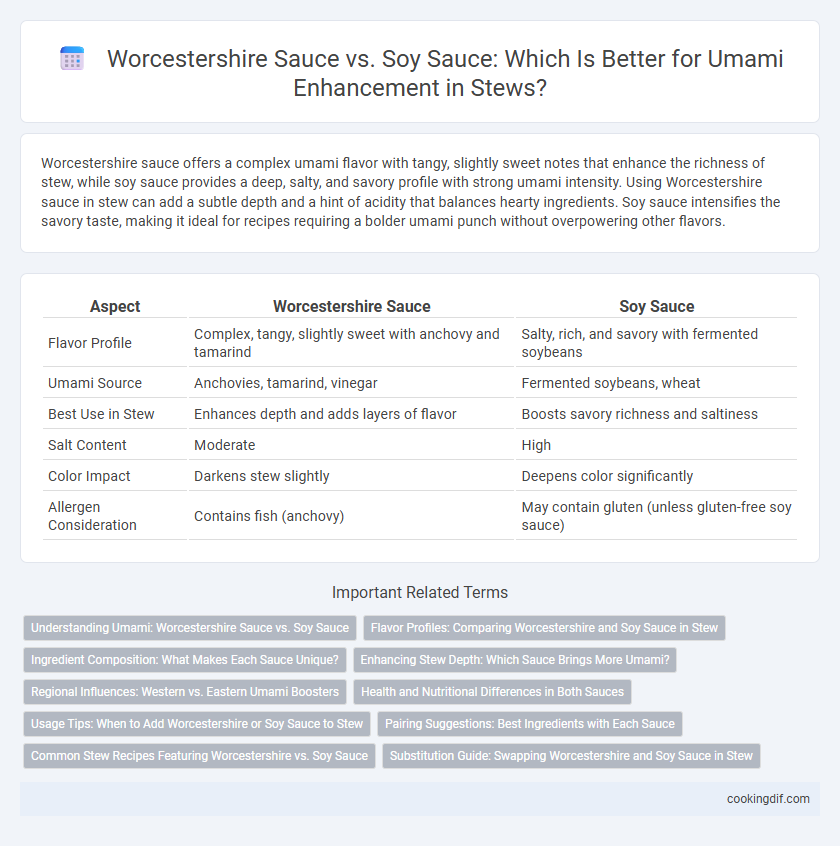Worcestershire sauce offers a complex umami flavor with tangy, slightly sweet notes that enhance the richness of stew, while soy sauce provides a deep, salty, and savory profile with strong umami intensity. Using Worcestershire sauce in stew can add a subtle depth and a hint of acidity that balances hearty ingredients. Soy sauce intensifies the savory taste, making it ideal for recipes requiring a bolder umami punch without overpowering other flavors.
Table of Comparison
| Aspect | Worcestershire Sauce | Soy Sauce |
|---|---|---|
| Flavor Profile | Complex, tangy, slightly sweet with anchovy and tamarind | Salty, rich, and savory with fermented soybeans |
| Umami Source | Anchovies, tamarind, vinegar | Fermented soybeans, wheat |
| Best Use in Stew | Enhances depth and adds layers of flavor | Boosts savory richness and saltiness |
| Salt Content | Moderate | High |
| Color Impact | Darkens stew slightly | Deepens color significantly |
| Allergen Consideration | Contains fish (anchovy) | May contain gluten (unless gluten-free soy sauce) |
Understanding Umami: Worcestershire Sauce vs. Soy Sauce
Worcestershire sauce contains anchovies, tamarind, and molasses, providing complex umami notes with a slightly sweet and tangy flavor that enhances stew depth. Soy sauce, derived from fermented soybeans, delivers a rich, salty umami boost with a distinct savory profile ideal for balancing hearty meat and vegetable stews. Both sauces intensify umami through glutamates but differ in flavor complexity, making Worcestershire suitable for layered taste and soy sauce optimal for straightforward, robust savoriness.
Flavor Profiles: Comparing Worcestershire and Soy Sauce in Stew
Worcestershire sauce imparts a complex umami flavor with tangy, savory, and slightly sweet notes derived from ingredients like anchovies, tamarind, and molasses, enhancing the depth of stews. Soy sauce offers a robust, salty umami profile rooted in fermented soybeans, providing a rich and slightly earthy taste that complements hearty stew ingredients. Choosing Worcestershire sauce adds a layered, slightly acidic complexity, while soy sauce delivers a more straightforward, intense savory boost.
Ingredient Composition: What Makes Each Sauce Unique?
Worcestershire sauce combines tamarind, anchovies, molasses, vinegar, and spices, creating a complex flavor profile rich in umami from fermented fish and sweet acidity that enhances stew depth. Soy sauce, made primarily from fermented soybeans, wheat, salt, and water, delivers a robust umami punch with a salty, slightly sweet taste that intensifies savory dishes. The anchovy-driven umami in Worcestershire contrasts with the pure soy-derived glutamates in soy sauce, making each uniquely suited for different stew flavor dimensions.
Enhancing Stew Depth: Which Sauce Brings More Umami?
Worcestershire sauce offers a complex umami boost to stew with its blend of anchovies, tamarind, and molasses, enriching the depth of savory flavors. Soy sauce provides a strong, salty umami punch derived from fermented soybeans, creating a robust and slightly sweet background. Choosing Worcestershire sauce enhances layered, tangy notes, while soy sauce intensifies the stew's overall umami richness.
Regional Influences: Western vs. Eastern Umami Boosters
Worcestershire sauce, with its complex blend of vinegar, molasses, anchovies, and tamarind, embodies Western umami profiles that enrich stews with a tangy, savory depth. In contrast, soy sauce, a staple of Eastern cuisine, delivers a salty, fermented umami flavor derived from fermented soybeans and wheat, enhancing stews with a rich, umami-packed savoriness. Regional culinary traditions influence these choices, where Worcestershire sauce typically complements robust meat-based stews in Western recipes, while soy sauce is favored in Eastern stews for its balanced, umami-enhancing properties.
Health and Nutritional Differences in Both Sauces
Worcestershire sauce contains a blend of vinegar, molasses, anchovies, and spices, providing a rich umami flavor with fewer calories and lower sodium compared to soy sauce. Soy sauce, made from fermented soybeans and wheat, offers higher protein content but typically contains more sodium, which may impact blood pressure if consumed excessively. Both sauces add distinct savory depth to stew, but Worcestershire sauce is often preferred for a lower-sodium option enhancing umami with added vitamins from anchovies.
Usage Tips: When to Add Worcestershire or Soy Sauce to Stew
Add Worcestershire sauce toward the end of cooking to preserve its complex umami flavors and tangy notes, enhancing the stew's depth without overpowering other ingredients. Soy sauce should be incorporated earlier in the cooking process to allow its rich, salty umami to meld seamlessly with the stew's base. Both sauces boost umami, but timing their addition optimizes flavor balance and prevents bitterness.
Pairing Suggestions: Best Ingredients with Each Sauce
Worcestershire sauce pairs exceptionally well with beef, lamb, and root vegetables, enhancing their rich flavors with its complex blend of tamarind, anchovies, and molasses. Soy sauce complements ingredients like chicken, pork, mushrooms, and bok choy, providing a salty, savory depth that intensifies umami in Asian-inspired stews. Using Worcestershire with hearty meats and soy sauce with lighter proteins and umami-rich vegetables optimizes flavor balance and depth in stew recipes.
Common Stew Recipes Featuring Worcestershire vs. Soy Sauce
Worcestershire sauce is commonly used in classic beef stew recipes for its complex umami flavor derived from anchovies, tamarind, and molasses, enriching the broth with a savory depth. Soy sauce, prevalent in Asian-inspired stews such as Japanese sukiyaki or Korean beef stew, imparts a salty, fermented umami that enhances meat and vegetable flavors. Both sauces elevate stew dishes by intensifying taste profiles, but Worcestershire adds a tangy sweetness whereas soy sauce delivers a richer, saltier finish.
Substitution Guide: Swapping Worcestershire and Soy Sauce in Stew
Worcestershire sauce offers a complex umami profile with tangy, savory, and slightly sweet notes, enriching stew with depth and subtle acidity. Soy sauce delivers a straightforward, salty umami flavor, intensifying the stew's savory taste without added sweetness or tang. When substituting, use soy sauce for a cleaner, saltier umami, and Worcestershire sauce to add layers of flavor; balance the dish by adjusting salt and acidity accordingly.
Worcestershire sauce vs Soy sauce for umami enhancement Infographic

 cookingdif.com
cookingdif.com